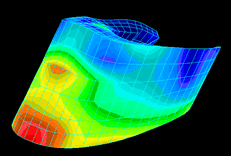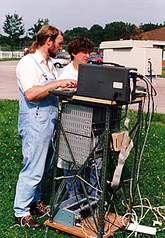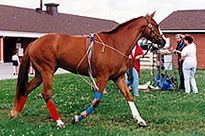
What Lies Beneath:
A Commitment To
Understanding The Horse's Hoof
Written by: Kelly
Counsell & Gayle Anderson
Professor Jeff Thomason
of Biomedical Sciences at the University of Guelph has a foot fetish.
For horse's feet, that is. He would have to be passionate to understand
all there is to know about how horse's feet work: how the laminae stretch
and strain under enormous loading; how the coffin bone and the hoof wall
are married by these laminae - until death do them part; and how human
intervention from rider to blacksmith affect this complicated structure.
An engineering marvel, really.
A horse's hoof is
composed of the same protein as human fingernails, but unlike fingernails,
a hoof is designed to be the only interaction between the foot and the
ground. "Not many animals run on their fingernails, and the ones that
do have modified them extensively to do that," explains Thomason.
Dr. Thomason has dedicated
much of the last ten years of his life to the study of horse's feet. Now
with the help of Heather McClinchey, resident technician, the pair has
developed a digital model of a horse's foot. Based on data collected in
the field, the model is programmed to respond to the same kinds of force
that the real foot experiences. As testing and fine tuning continues,
the model appears to be responding as would a normal foot under the same
conditions.
 |
Thomason
and resident technician Heather McClinchey have developed a digital
model of a hoof that responds as a normal hoof would, indicating
deformation and pressure points.
|
"We hope to create
an accurate digital model that has practical applications," said Thomason.
"With this tool we may be able to predict an individual horse's response
to certain conditions, such as trimming, shoe type and gait."
Data collected for
this project came from field studies, in particular a study at Sunrise
Equestrian Centre, a therapeutic riding facility serving Guelph and the
surrounding area. The one-year study was designed to investigate the mechanics
of the hoof and the strain put on it during activity before and after
a visit with a farrier. Placing electronic sensors in key positions on
the hoof and measuring the strain experienced by the foot at different
levels of activity accomplished this.
The Sunrise study
examined the careful artistry of their farrier Phil Robinson and showed
that the trimming of the horses had little impact on the existing strain
patterns. Thomason is curious to look at more dramatic shoeing and trimming
practices in the industry, such as the hotly debated "long toe, low heel"
hoof angle, and how it affects the mechanics of the foot.
The field study at
Sunrise was a great example of industry working with academics for the
benefit of horses. "The partnership with Sunrise was great," said Thomason.
"They were happy to volunteer their horses, and we really appreciate their
help because there was a fair time commitment on their part."
 |
***Professor Jeff Thomason collects
hoof strain data in the field with horses before and after a visit
with their farrier
|
 |
Field studies are
not always glamorous, requiring extra work and presenting challenging
situations for both researchers and the participating farm or trainer.
Yet Dr. Thomason has always valued the data that can be gained in field
and has worked with industry farriers in the past. From 1993-1996 farriers
Anne Negri and John Staples collected measurements on the feet of over
150 thoroughbreds in training. This database is housed in Thomason's office
and contains very useful measurements of hoof shape that can be applied
to the digital model.
The Equine Program
at Guelph is looking to the industry to support their research, and working
hard to provide the feedback and practical information the industry needs.
www.erc.on.ca
|

